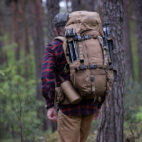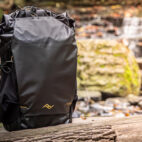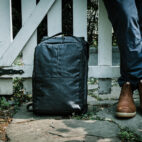Drive By :: CamelBak KUDU 12
As an obsessive mountain biker I am consistently thinking about how to carry better while on rides. Last Summer at Outdoor Retailer, I was introduced to a new pack line from CamelBak called the KUDU that was designed for the very type of racing that I enjoy most, enduro.
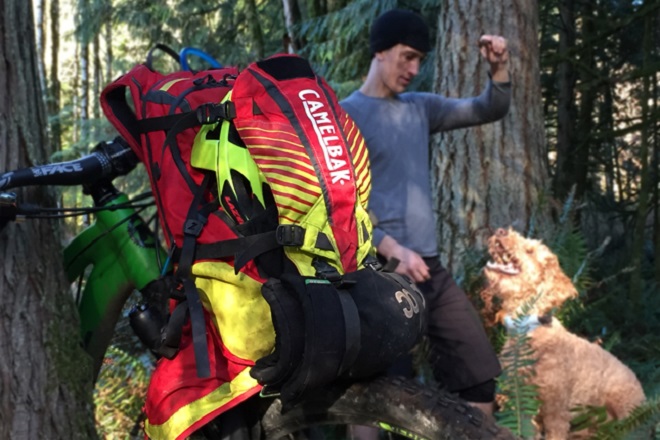
Enduro racing is a serious mountain bike-industry buzzword right now. The market is rife with “enduro specific” wheels, bikes, helmets, shoes and yes, bags. Pay no attention to the haters who say it’s all a fad though because there is a real reason for this trend being set. Some of the cause for its popularity is how accessible it is. You don’t need to be stunningly fit to have fun, nor do you need to be Evel Knievel on the way down. It is accessible (at least on a local level). So what is enduro then? Enduro is a race format that emphasizes only the descending part of a bike ride over a distance. Only the descents are timed, and the transitions between each stage are not, giving riders a chance to chat with their friends, perhaps relax a bit and eat some food.
To try and sum it up, enduro racing is much like a mountain bike ride with your pals. Here in Washington State, we lackadaisically ride bikes up logging or fire roads to the top of our trail, then rally down a descending ribbon of dirt as fast as we can. Enduro racing can have some interesting requirements and I was keen to see if the KUDU lived up to its task.
Specifications
Name: KUDU 12
Brand: CamelBak
Format: Backpack
Measurement: 19in / 48cm back panel
Capacity: 1098 cubic inches / 12 liters / 3 liter reservoir
Weight: 2lb 7oz / 1.21 kg
Zippers: #5, #8 YKK RC
Material: Nylon
Price: US$199.95
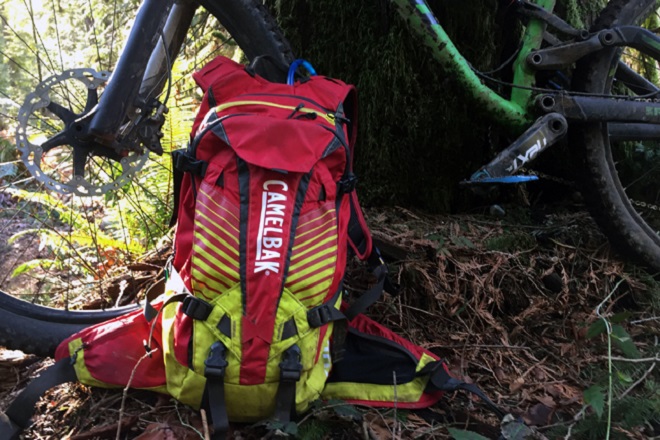
Who it suits
This is a solid choice for an everyday riding pack for those who prefer longer rides or are racing. The KUDU series of packs come complete with an integrated back protector, which is often de rigueur for European enduro racing. Racers and casual riders alike will like the options for carrying either a full face or half-shell helmet externally in a stable way. For those seeking bells and whistles, this pack is as versatile and feature-rich as they come.
Who it doesn’t suit
People who want to ride light. I have never consumed 3 liters of water in a single bike ride, and feel the volume might be a touch excessive for all but the longest of rides. The back protector, while a great feature, is heavy and adds to an already portly pack. While designed around the needs of enduro racing, often the emphasis is placed on lightness and mobility – and for those reasons, I believe many racers would prefer something more pared-down.
Design
Looks
I enjoy the design of the KUDU. I have a particular affinity toward carry that merges rounded and geometric elements. These colors scream “look at me!” – and while I got over it, I’d prefer the more subtle and old-school vibe of their grey/blue/neon pink motif to tone it back a bit more. When wearing it, the sleek profile hugs the back, and doesn’t appear out of place size-wise. I really like the treatment on the compression straps; the webbing terminates in an elegant way, making a bag with 6 external straps on the bag body look and feel sleek.
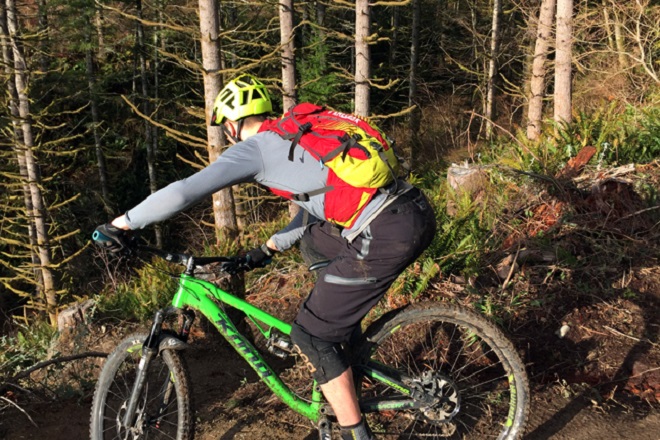
Construction
It’s getting harder and harder to find faults in high-end sewn goods these days. Quality and workmanship just keep getting better, and this pack is no exception. I’ve pulled at every strap, every buckle and every seam to expose weakness, to no avail. Sometimes it is hard even for me, a person who sews daily, to remember it was made by hand. The sewing is just that good. So here’s to you, sewers in the Philippines, I am truly impressed. Here’s to you too, CamelBak – when you think no one is looking, you still do it right. Under the binding, you still pay attention. There are many companies out there who should take a page from your book.
Materials
A solid combination of mid to lightweight nylons. The lighter of the two has a micro ripstop pattern, and the heavier was a block dobby woven. I thought these weights were entirely appropriate for the pack; they offered enough dimensional stability to hold its shape, but proved durable over the pack’s long testing period.
The shoulder foam is die cut to allow airflow, then sandwiched between a layer of airmesh and a layer of flat-woven mesh to further circulation and keep these areas cool when you are working hard. I’m not entirely convinced that this does much in terms of cooling, maybe there is a placebo effect – and if I were designing the pack myself, it’s something I’d likely repeat.
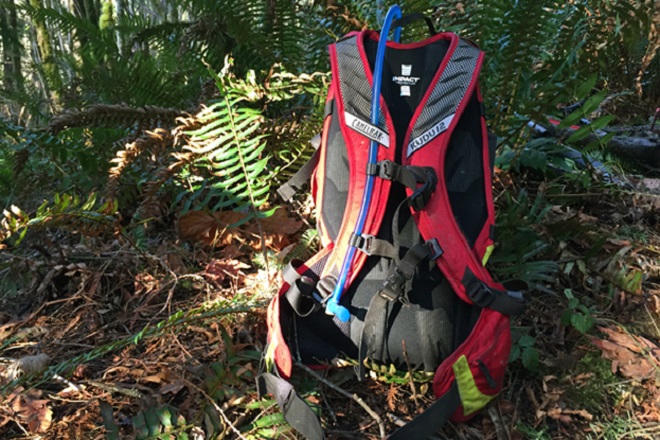
Hardware
Buckles: The KUDU features a standard complement of high-quality acetal ITW buckles. Acetal nylon is so common now that an industry friend didn’t know there were cheaper/poorer options out there. We are lucky for acetal buckles, friends.
Zippers: I guess I could consider myself a YKK fan boy. I wouldn’t spec any other brand of zipper on mine or a client’s project, so I’m always pleased to see when a company shares this value. I am also a big fan of #8 coil, and this pack is covered with it. All but one zipper was spec’d with the durable yet flexible tape. As someone who has repaired gear for a living, perhaps the best thing about a #8 or #10 zipper is that the slider body is slightly more robust than a #5, making it damn resistant to bending over time. Products that get dirty are wise to be spec’d with heavier zipper, as getting grime into the zipper teeth is a great way to create drag in the system. This leads invariably to pulling on zippers harder, likely leading to bent sliders and a busted pack.
Features
Outside Pockets
Hip Pockets: I love to grab a snack from my bag while riding instead of stopping and fumbling through the main part of my pack. The KUDU’s hip pockets are perfect for this cause. One zips closed and the other utilizes two cleverly overlapping layers of stretchy mesh to contain your food. Perhaps you could store a cell phone in the zipped pocket, but I didn’t feel confident that I wouldn’t just wreck and smash the damn thing with my hip. They are so unobtrusive that I forget how much trash has accumulated in them every ride. Training weight.
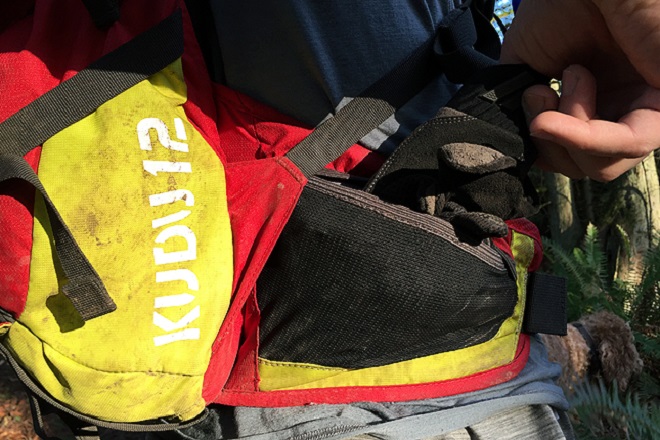
Softy Pocket: A soft top pocket proved a perfect place to stash my shades before popping into the dark Pacific Northwestern woods on trail. Alternatively, you can put sensitive things in this zone like a phone or small camera.
Rain Cover: I removed this immediately and can’t think of an instance when I would actually use it.
Helmet Carry: To keep liability to a minimum, enduro racing often requires the use of a helmet at all times during a race. Sometimes race stages can be technical, steep and/or fast enough to necessitate a full face helmet (and some races require it), thus the racer always wears a full face helmet, even on the climbs – or carries two helmets. This can be maddening when it’s 30 ºC and you need to ride up a 2500′ road in direct sun. Enter the helmet holder. This guy is designed to hold a full face for your climbs, and a half-shell for descending. It does its job perfectly, with enough rubberized material on the inside to keep a hold on your half-shell and clips for the full face.

Harness
This is the most important part of the pack in my opinion. When riding, and particularly when racing, it’s vital to have the pack fit snugly against your back to the point it won’t move even if you were to jump up and down. To control for this, CamelBak applied a dual sternum strap and a 1.5″ waist belt attached to large (7″ tall) wings which hug your hips. I found I needed to have things buckled down quite tightly to keep the pack from bouncing when launching off jumps. The dual sternum straps were the most positive when pushed to the furthest up and down positions to leverage additional stability over a single buckle.
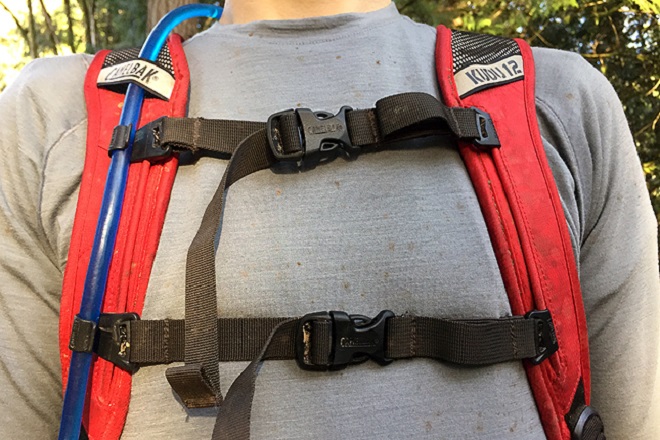
Inside Pockets
CamelBak focused on simplicity on the inside of the pack, a zipped mesh upper pocket, central tool pocket and bottom. The bottom pocket was a perfect spot to securely store a spare tube in a semi-permanent way. I jammed one down there and forgot about it. The tool pocket came with a nifty roll-up tool pouch, which I actually used. I suppose it stands in for a plethora of internal pockets, and I approve, though I don’t think I’d want to pull off my pack to access it during a race. I put a spare CO2 cartridge and adaptor in the zipped hip pocket along with a chain breaker for mid-race catastrophe.

Back Protection
I hesitate to even think about crash-landing on my spine during a bike race. Thoughts of flipping wildly through the air after blowing a turn or doing some wrong steering… Being systematically obliterated by trees and rocks as I tumble through the forest – my bike in hot pursuit tomahawking toward an awkward entanglement with me as I crumple… It’s not fun to imagine.
That said, the back protection element of the KUDU 12 is nice to think about when you are preparing yourself to launch down a trail full of death at top speed. The thing is made up of three layers of special foam designed to absorb impact. Helmet, check. Knee pads, check. Back protector? Check. How can you hate that?
Alternatives to consider
The EVOC FR Enduro was a similar pack we tested back in 2013 that did a lot of what the CamelBak KUDU 12 does, only the hip belt was much better. I enjoyed the hip pockets on the KUDU, however. Another option is the POC VPD Spine series, though I have no first-hand experience with it.
The good
Awesome hip pockets
Solid construction
Strong zippers
Good for a wide array of audiences
The not so good
Enduro not-so-specific
Zip-pulls and back panel hardware could be better
Airmesh detracts from the look and feel of the bag
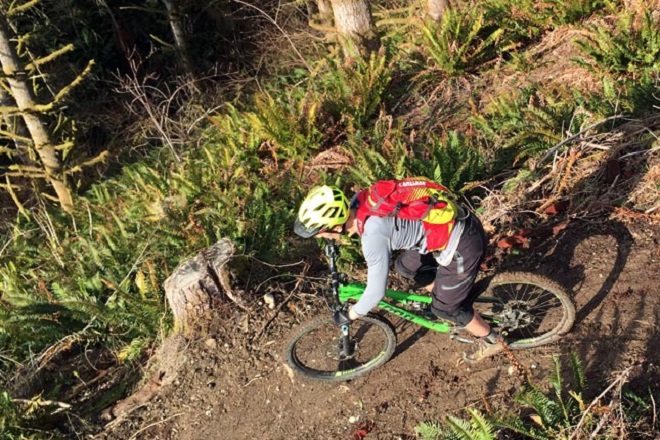
The Verdict
CamelBak continuously drives forward its hydration systems in a competitive atmosphere, one which they pioneered. I’ve been riding with the pack for nearly 4 months now, 2-3 times per week, and recently switched back to the EVOC Enduro pack for comparison. The CamelBak really shines on overall pack size as well as features like the large hip pockets with two different options for storing items. I found the dual sternum straps didn’t work as well as I had hoped, but nobody mentioned the fact that my pack had two of them hanging off of it. The tall “wing” pockets are not as effective at stabilizing a load and keeping the pack from bouncing as the EVOC bag, but vented much better. In the end, I would recommend this pack for users looking for a lightweight, great-looking pack that is as comfortable in a race as it is on a 7-hour all-day epic.
As always feel free to ask questions in the comments below!
–





 Carry Awards
Carry Awards Insights
Insights Liking
Liking Projects
Projects Interviews
Interviews






